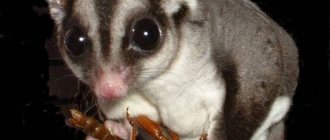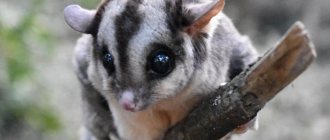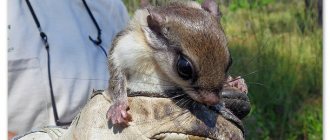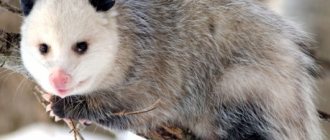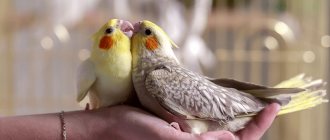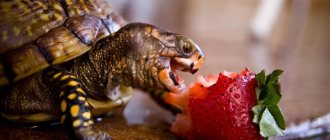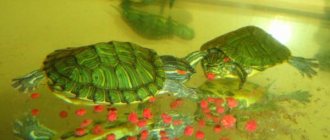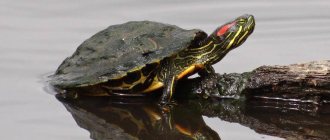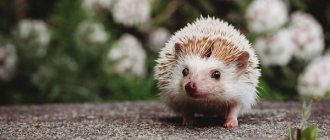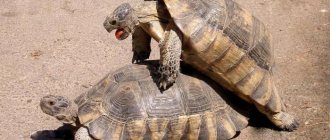Rodents 7319
The sugar squirrel is the smallest marsupial in the world. This is an incredibly charming marsupial: the fur is pleasant to the touch, like plush, large eyes like saucers and a soft pink nose. The possum has excellent manners: he is unusually good-natured, endlessly curious and easily tamed. The sugar glider has many names, which will be used periodically throughout the article.
Appearance of a sugar glider
In appearance it bears quite a strong resemblance to a squirrel. The animal has miniature dimensions: the body is up to 21 cm, the tail is 16.5–21 cm, and the weight does not exceed 170 grams. The sugar flying squirrel has a rather thin body, although due to the flight membrane it has, the opposite impression is created.
The body is covered with dense, velvety fur, the tail exceeds the size of the body and is also fluffy. The possum's muzzle is slightly pointed and shortened. The ears and eyes are large, the former are quite mobile. The sugar squirrel has a variegated color: the back is ashen, there are brown stripes on the face, and the belly is white with a sandy tint.
There are a total of 5 toes on the paws: on the front paws, the first 2 are opposed to the other 3, on the hind paws, the first toe is opposed to the others. The 2nd and 3rd toes are partially fused on the hind limbs.
The main exocrine glands - for marking territory - are located on the forehead, chest and near the anus. Males have a bifurcated genital organ. Females have a pouch on their abdomen for bearing offspring.
Cell
For one individual you will need a cage with a tray, an aviary, a terrarium or a display case with dimensions of 50-50-80 cm, for two 140-50-80 cm. It is better to provide the largest possible conditions. If a cage is used as a container, the bars should not be narrower than 1 cm.
Reference cell
What should be in the cage
Be sure to have a drinking bowl and several feeders. It is important that the squirrel is habituated, otherwise it may die of thirst. Small metal or ceramic feeders are required.
Inside the cage you need climbing structures, a house, branches, pipes, etc.
What shouldn't happen
There should be no materials inside the cage that could poison the animal. Curiosity and constant contact can cause a squirrel to try something, which can affect its health.
Lifestyle
Their peak activity occurs in the dark, and the day for them is sleep time. The animals nest in safe, secluded places, usually hollows or other recesses in trees.
These are social animals that live in flocks. One flock can include up to seven mature individuals and broods from the current breeding season. In a flock there is certainly a leader (a mature, dominant male), who marks the territory and possums from the family with his secretions. The territory is jealously guarded; strangers who do not have the mark of a leader are immediately expelled from its borders.
Marsupial flying squirrels are heat-loving, and with the onset of cold weather they hibernate. During the dry season and rainy nights, their activity also decreases significantly. This feature helps possums survive those seasons in which the ability to obtain food is severely limited. In natural habitats, sugar squirrels hibernate much more often than their domesticated counterparts. Wild possums feed on the sweet sap of acacias, eucalyptus and other trees, nectar and pollen from flowers. Their diet also includes insects, small animals and birds.
Walks
If you want your pet to be healthy and happy, at least once a day he needs a walk outside the cage, lasting at least an hour. During such a walk, the possum will climb onto any object that it sees on the way, glide, including at you, and also stick its nose into every loophole.
During the flight, possums touch and knock over small objects from tables and other surfaces. Therefore, get ready to be on guard and remove expensive items and objects dangerous for the animal from the “walking” room in advance. It is better to curtain glass and mirrors; flying squirrels do not notice them and can be seriously injured.
Males
In males, there are a significant number of glands on the body, the most noticeable of which are on the forehead (bald patch) and chest. They are formed as the possum boy matures. In a sexually mature male, the exocrine glands produce an oily secretion with a characteristic odor. In a castrated possum, the hormonal levels decrease, as a result of which the bald patch can become completely overgrown. In males, there is a “pompom” on the abdomen with testicles placed in it; the forked penis has a pink-red hue. The reproductive organ may occasionally be shown outside, this is how it is cared for.
Diseases
Possums suffer from a fair number of ailments that affect their lifespan. Most often they are affected by metabolic bone disease associated with injury and poor nutrition. Possible diarrhea from overloading the stomach with fruit or due to parasites. Any treatment is carried out under the supervision of a veterinarian.
I am engaged in professional breeding of hamsters and rats on an ongoing basis. I know something about them that most people don’t know. Always open to constructive discussion
Post Views: 1,748
Females
In females, like in males, there are many, but less pronounced, exocrine glands located on the body. The vagina and uterus of female possums are bifurcated and separated from each other, similar to the male’s penis. On the belly of the female short-headed flying squirrel there is a pouch, inside it there are 4 nipples. The bag should not be red or swollen, otherwise this is evidence that the animal is unhealthy.
Flying squirrels have a short gestation period - up to 17 days. As a rule, from 1 to 3 cubs are born, the size of a steamed grain of rice. After giving birth, the female possum licks the cubs and licks her fur, smoothing the way from the newborns to the pouch. Along this “path” they move to a cozy “house”, where they attach themselves to the nipple, after which it swells. They will remain in this position until the moment they are able to get out. The “journey” takes about 5 minutes, and the babies will mature in the bag for another 60–70 days.
After leaving the “house”, the cubs need another 8 weeks to adapt to the outside world and switch to the diet for adults. While this is gradually happening, the babies continue to be on a milk diet.
Notes
- ↑
Complete illustrated encyclopedia. "Mammals" Book. 2 = The New Encyclopedia of Mammals / ed. D. MacDonald. - M.: "Omega", 2007. - P. 436. - 3000 copies. — ISBN 978-5-465-01346-8 - ↑ 1 2 3 Sokolov V. E.
Five-language dictionary of animal names. Mammals. Latin, Russian, English, German, French. / under the general editorship of academician. V. E. Sokolova. - M.: Rus. lang., 1984. - P. 20. - 10,000 copies. - ↑ 12
Turner, James R. Mammals of Australia. p.173 - ↑
A guide to medicine and surgery in sugar gliders
Keeping at home
Flying squirrels are quite active and are kept either in a spacious cage or in an aviary. The minimum dimensions for a pair of animals are 80x80x60 cm, however, the higher the cage, the better. The walls and ceiling should have bars no larger than 1.5 cm, otherwise the cubs will be able to squeeze between them or even fall out.
The door must be equipped with a lock or carabiner. These animals are very inventive and easily learn to open an unfixed passage on their own. The floor is covered with a specialized filler for rodents in the form of compressed sawdust.
Branches are a must when keeping sugar gliders. In their natural habitat, they live in trees; these animals have the instinct to climb wood.
It is best to place bowls on shelves and in different parts of the cage or enclosure. This will help keep the water uncontaminated longer.
The house is an invariable attribute of the possum’s habitat. The ideal option would be a suspended structure, fixed as high as possible. The following can be used as a nest: plywood or wooden boxes, something soft and at the same time reliable, for example, a knitted pocket. Flying squirrels passionately adore cozy, soft nesting places, so if the frame of the house is hard, you should put rags or hay in it.
It is permissible to use several nests at once, however, while feeding the brood, it is worth limiting yourself to one.
Toys should be chosen that are made of hard plastic. The following are perfect for flying squirrels: tunnels, stairs, running wheels, bells, mirrors and small balls. Toys require periodic updating to maintain the animals’ interest in them.
Care of fur and claws
The Australian flying squirrel is a fairly clean representative of the animal world. Along with clean cats, she licks and cleans the fur with her tongue and claws, so no fur care is required on the part of the owner.
Bathing a squirrel is contraindicated. She is not afraid of water, but she absolutely cannot swim and, left without proper supervision, can easily drown even in a jar of water. If the possum suddenly gets very dirty with something, carefully wipe it with a damp cloth (unscented) or a cotton sponge soaked in boiled water. After this procedure, the animal should be thoroughly dried with a towel and, until it is completely dry, should not be allowed to be in a draft or in a cool place.
Some people install a sand bath in the cage for bathing, but this is not necessary. Possums also do not swim in sand.
Marsupial flying squirrels grind their claws down on their own - on tree branches that should be in the cage. If for some reason the nails have grown too long, you need to trim them yourself using a special nail clipper for cats and dogs. This should be done very carefully so as not to damage the vessel passing inside the claw. If it is still damaged, dip the squirrel's claw in dry potassium permanganate or use a special hemostatic pencil from a veterinary pharmacy. It is imperative to get rid of overgrown claws. Otherwise, they will grow into the paw pads and cause discomfort and pain to the animal.
If your sugar glider has a lot of resistance to trimming its nails, try wrapping its paws in a fleece rag and removing one toe at a time for clipping. It is most convenient to cut the hair together or while distracting the pet with some treat. Many breeders recommend carrying out the unpleasant procedure during the daytime, while the animal is sleepy.
Breeding
The breeding season for flying gliders living at home is year-round. When keeping a female and a male at the same time, when both are ready, they will definitely mate. In this case, the animals will absolutely not care whether they are related.
This point is very important, and you need to take it into account when keeping related gliders in the same cage or enclosure. If you allow such mating, their genetic diversity will be disrupted, which can lead to weak and sick offspring.
When planning to continue to keep relatives together, it is better to castrate males. Males are castrated at 13 weeks after emerging from the pouch. Potentially, it is possible to sterilize a female individual, however, in practice this is undesirable due to the special structure of the intimate organs and the small size of the animal.
Such an operation is carried out only for special indications. When intending to acquire offspring of possums, it is worth waiting for not only their sexual, but also psychological maturity. The optimal age for breeding for both boys and girls is after 1 year, but not earlier than 10 months from the moment they emerge from the pouch.
At this age, males are fully ready to raise offspring, and females significantly reduce the risk of abandoning their cubs. In addition, the mother possum will spend less energy on feeding, and the babies themselves will be stronger and healthier.
During mating games, sugar squirrels can behave somewhat aggressively. At this time, it is worth periodically inspecting the animals for injuries caused to each other and, if necessary, treating them. This way you can avoid infection and keep your pets healthy.
During gestation, the female's diet should be enriched with up to 50% animal proteins, but the level of fat should be kept low. Do not try to feed the animal beef or soy products, they are not suitable. Excellent options include chicken, mealworms, crickets and other sources of protein.
A nursing mother will benefit from a slight increase in the level of fat in her diet. It is extremely important to avoid stressful situations for the female during the gestation and feeding stages. At this time, you should not touch it or show it to anyone; it is also advisable not to methodically check the nest yourself. The male, like the female, should be inviolable during this period, because he is now the protector of the family and can harm you in self-defense. This parental behavior goes away when the brood becomes more or less independent.
Babies should not be separated from their parents for at least 8 weeks after leaving the pouch.
Feeding
The most important question that the happy owner of a sugar glider will have to face is what to feed the animal. Proper nutrition is the key not only to health, but, consequently, to a long and happy life. The smell and mood of your pet also depend on this.
In the wild, the sugar squirrel is an omnivore. The main part of its diet consists of fruits and insects. When feeding, you should adhere to the following principles and rules:
- The 70 to 30 rule – 70% of the diet is protein, the remaining 30% is carbohydrates.
- The feeders are filled with food and the drinking bowl with fresh water immediately before the flying squirrels wake up - at approximately 9 - 10 pm. In the morning, you need to clean the feeders and leave the water. If a possum has access to food 24 hours a day, it will suffer from obesity. Representatives of this subspecies are able to wake up in the daytime and sleepily drag a treat into the nest, falling asleep on the move, often with an unchewed piece of food in their paws. The maximum that can be left for the possum during the day is a piece of fruit or dried fruit, as well as a little juice diluted with water.
- If your pet doesn't drink for a long time, don't be alarmed. Sugar squirrels can get enough moisture from fruits. Despite this, water in the drinking bowl must be constantly present in the cage. It is better to use filtered or bottled water and change it at least once a day to prevent harmful bacteria from growing in it.
- Foods from the human table are prohibited for feeding: fatty, spicy, fried, salted, sausages, etc. The maximum that can be allowed is chicken or turkey meat, cooked without salt and spices.
- Sweets (honey, fruits) can be given to the animal in limited quantities - as a treat, to support the female during pregnancy and feeding the cubs.
- The food should contain as much calcium as possible (the domestic sugar glider is very sensitive to its deficiency) and as little phosphorus as possible.
- All vegetables and fruits should be cut into fairly large pieces that will be easy for the squirrels to pick up in their paws. The animal will not like small pieces.
Products necessary for the normal development of the dwarf flying squirrel:
Protein
- Insects – you can feed your pet live grasshoppers, fly larvae, crickets, mealworms and zoophobas (Latin worms, a favorite delicacy of the sugar glider). The daily norm for an adult older than six months is 2–3 zoophobass per day, 5–8 mealworms or 1–2 large banana crickets. All of these insects can be purchased at a pet store. Many sugar glider breeders breed gliders in plastic containers with sawdust. They eat cucumbers, apples and cereals. They can live up to 3 months. You can also feed the possum no more than once a week with one-day-old chicks or other small chicks.
- Meat - about 30 grams per day per individual, boiled without salt and spices, lean (chicken or turkey).
- Fermented milk products - no more than 2 times a week: natural low-fat cottage cheese, kefir, yogurt, fermented baked milk, children's curds and yoghurts without preservatives and additives, including sugar-free.
- Quail eggs without shell - no more than once every 7-10 days.
- Baby food – puree for first feeding, possibly with meat.
- Porridge - once every 7 - 10 days, they must be cooked exclusively in water, since milk is extremely harmful for flying squirrels. The healthiest ones are oatmeal and buckwheat, you can add fruits, dried fruits, candied fruits, honey (literally a drop per serving).
Carbohydrates
- Whole fruits and vegetables are the main source of carbohydrates. A possum needs about 35–40 grams of fresh, unprocessed fruits and vegetables of various types per day. These can be peaches, oranges (if the possum is older than six months), kiwis, apples, pineapples, bananas, avocados, watermelon, melon, cucumbers, tomatoes, sweet potatoes, mangoes, papaya, carrots. Products with a laxative effect (beets, pears, plums) should not be offered to your pet.
- Juices and fruit purees – up to 20 ml per day. It is advisable to give the animal freshly squeezed juices diluted 1:1 with water, or juices and purees intended for children under 3 years of age, without preservatives and sugar.
- Any dried fruits, except prunes - 1 - 2 pieces per day (cherries, pineapple, dried apricots, etc.).
Treats
- Nuts – 2 small or 1 large nut per week (peanuts, hazelnuts, pine).
- Honey - only as an additive to the main food, about 1.5 teaspoons per week.
- Drops – no more than one per day.
Vitamins and minerals
Regular intake of calcium and multivitamins is recommended. Usually they are crushed into powder, rolled into insects and fed to pets. Some breeders dissolve the powders in sweet fruit juice or puree. The exact dosage must be selected based on the weight of the animal and the instructions on the package. You can purchase these supplements from online stores specializing in exotic animals or from veterinary pharmacies.
Description, appearance
The sugar glider is a relatively small marsupial . The marsupial flying squirrel is the tiniest relative of the opossum family. Its head and body are approximately 120-220 mm long, and its tail is about 150-180 mm. The weight of a mature animal reaches only 140 grams, with a body measuring 15-20 cm and a tail length of up to 19 cm. There is a dark stripe along the back from the back to the nose. There are similar stripes on the muzzle, in the direction from the eye to the ear. There is a small white mark on the tip of the tail. Like flying squirrels, sugar gliders have a membrane of skin that extends from the outside of the front leg to the ankle of the back leg, and can be opened by spreading the limbs wide. The female sugar glider has a significant difference in body structure - a small pouch in the skin fold to accommodate the baby.
This is interesting! The possum has large dark eyes, dark colored ears and a pink nose. During flight - gliding through the air, a "flap" of skin extending from the front legs to the hind legs gives the possum's small body a prostrate, square shape.
A flap extending from the fifth toe of the front paw to the first toe of the hind paw allows this small marsupial to glide between trees up to 50 meters away (usually in search of food or new nesting sites). Sugar gliders are sociable animals and can communicate using a wide variety of sounds.
These are various signals, such as an alarm that sounds like a small dog barking. The size of the territory of a possum group is about a hectare. When the sugar glider emerges from the tree, it spreads its four limbs, releasing a membrane that functions like a parachute. The animal can change the curvature of the membrane by moving its legs to regulate the process of gliding through the air, and also uses its tail as steering control.
Return to content
